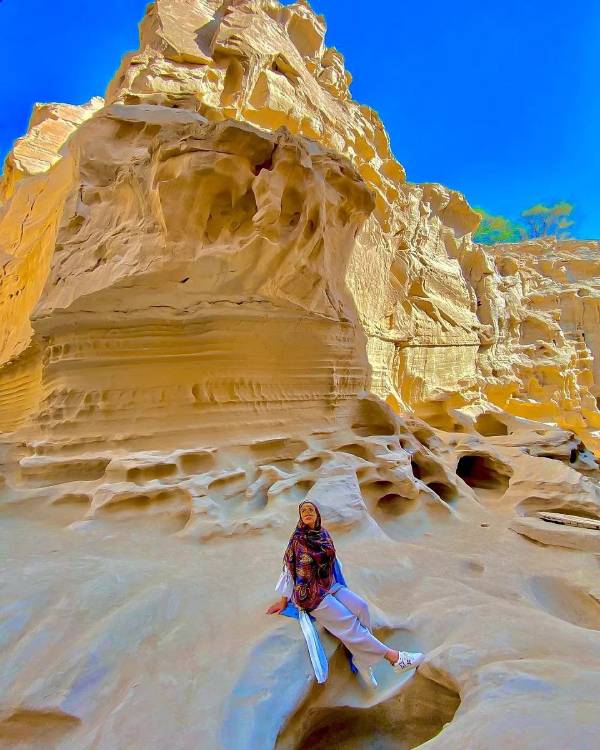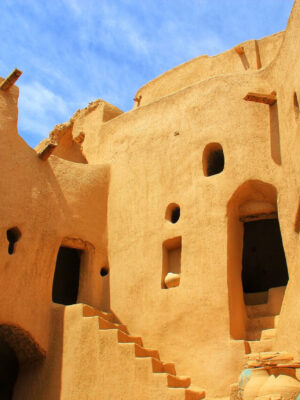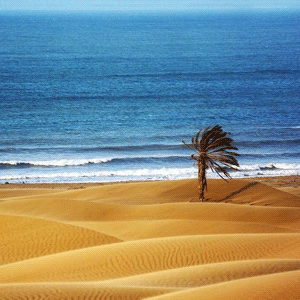Qeshm Island
Qeshm Island is the largest island in Iran which is located in Hormuzgan province and Strait of Hormuz. It also reaches Bandar Abbas from the north, Lark Island from the east, Hengam Island from the south, and Tonb islands from the southwest. In this article, we will introduce you to beautiful Qeshm Island.

Specifications of Qeshm Island
- The area of the island is about 1491 km, which is larger than 20 countries in the world!
- The Portuguese ruled the island for more than a century, and then it was the turn of the Dutch and the British. But in the end, its authority returned to Iran.
- In recent years, due to the expansion of commercial markets and great economic prosperity, many immigrants have come to Qeshm. Commercial, fishing, and tourism ports in Qeshm are numerous. Access to the beautiful islands of Hengam, Hormoz, and Lark, around Qeshm, is via the pier of these ports.
- Qeshm has a hot and humid climate. The meteorologists estimated the average temperature on the island is at 26 degrees. Meanwhile, they have recorded the maximum and minimum temperatures so far at 50 and 18 degrees Celsius.
- The architecture of the island’s houses is appropriate to its climate, and windcatchers play an important role in their construction.
- The main language of the people of Qeshm, like all Iranians, is Persian. The local and common dialect of the people of Qeshm in its cities and villages is almost the same. In general, the local language of Qeshmi is a mixture of Arabic, Persian, Bandari, Hindi, and English.
Attractions
Portuguese Castle of Qeshm Island
Qeshm Portuguese Castle was built in 1507 by order of Afonso de Albuquerque on Qeshm Island.
The main use of the castle was a large warehouse or a place to store ammunition and weapons, and in case of emergency, it supported castles such as Hormuz, Qeshm, and Lark. The rainwater and well water supplied the water for the castle. People directed water to different sections by an underground canal.
This castle has an area of more than 2000 square meters. The castle construction materials include limestone and gypsum with mortar. The castle building has been strengthened several times over the past hundred years. In the four corners of this castle, there are four tall towers and fortifications on which the cannon and catapult were placed.

Portuguese Castle of Qeshm Island
Star Valley of Qeshm Island
Star Valley is a collection of mountains, valleys, and cliffs that date back to about two million years ago. The geometric shapes of Star Valley are made of sand, stone, and calcareous cement.

Star Valley
Over time, these mountains and cliffs have changed due to rain, wind, and so on. This change has created different shapes between mountains and cliffs. Locals believe that a star hit a rock in the area and shaped the cliffs. As a result, locals call it the Valley of the Stars.
Chahkuh Gorge
Chahkuh Valley is so beautiful and unique that one feels one has stepped onto another planet!
The gorge has rocks that have been amazingly eroded over time. You can see this formation only in a few limited places in the world. The limestone cliffs of this region have regained their present appearance for millions of years with strong winds and water flowing.
Chahkuh gorge is connected to the Zagros Mountains. This gorge includes the main valley and the valley perpendicular to it and forms a cross-shaped shape.
Chahkuh has four gorges on all four sides, the walls of which have reached each other, and the gorge can be entered from all of them. When we enter the gorge from one side, after traversing a relatively short path, we encounter two grooves on both sides, each of which leads us to a new path with new features.

Chahkuh Gorge in Qeshm Island
Lime or calcium bicarbonate in the gorge wall reacts with the acid in the rainwater and dissolves in it. This process creates small cracks and holes. Water cannot penetrate these rocks; As a result, this erosion occurs layer by layer, and water re-emerges or evaporates after spinning in the cavities.
The repetition of this process over time causes the cavities to become larger day by day and form deep grooves in the wall and bottom of the valley over millions of years.
Khorbas Cave in Qeshm Island
Khorbas Cave is 15 km from Khorbas village and is one of the best places to visit in Qeshm. This cave is one of the ancient and at the same time strange geological phenomena. What seems mysterious and amazing are the works of rock architecture in different parts of the cave, which show the presence of humans in this area. The carving of the cave by them dates back to the time of the Medes in the 1st millennium BC.
Some archaeologists believe that this cave was a place for the worshipers of Mehr ( Mithras) or a place where the bones of the dead were kept in the time of the Medes.

Khorbas Cave in Qeshm Island
Salt Cave of Qeshm Island
Qeshm salt cave has several halls with different dimensions. The first vestibule of this cave is about 670 meters away from its entrance. The average width of the cave is five meters. The salt in this cave is the best type of table salt and there are other elements in its composition such as magnesium.
Scientists introduced the salt in this cave also as medical salt, and this salt can be used by professional athletes. Also, due to the salt and materials in this place, the salt cave is a suitable place for respiratory patients with asthma, and its presence can be effective in improving their disease.

The Salt Cave was discovered by geological engineers from the Czech Republic in collaboration with Shiraz University in 1998. The discovery of this phenomenon as the longest salt cave in the world made it visible to everyone. It was quickly covered in prestigious magazines and media.
The beauty of the cave increases from the middle to the end, despite the crystalline salt floor. Due to the connections of stalactites and stalagmites near the walls, beautiful columns have been created that are very enjoyable to watch.
Laaft village
People know this village as the village of windcatchers in the south of Iran. Laaft is a spectacular place to watch the sunset.
This village is very old and its formation dates back to the first millennium BC. The remains of ancient tombs in this area and the excavations of archaeologists in it are evidence that confirms the beginning of the island’s civilization from this point.
In the past, Laaft played a very important role in trade between Iran and various countries. People of this village from ancient times to recent times sailed across the ocean and traded with African countries and India. In addition, some of the elderly residents of Laaft are still fluent in Hindi, Swahili, Arabic, English, etc.
Laaft village provided ideal conditions for people’s lives due to the existence of sea routes and facilitating water communication, mangrove forests, access to fresh water, and monsoon winds. This village was safe from the enemies and its inhabitants could live in security.
In Qeshm Island, the temperature reaches more than 50 degrees during the summer. Therefore the reflection of the sun in the water along with the high humidity of the air makes living conditions very difficult. For this reason, the people of the village used windcatchers to cool the house. The shaft of the windcatcher is very high; because the wind gains more power at altitude and enters the windcatchers.

Qeshm Island has many attractions of which we have described only a few in this article. By traveling to Iran in autumn or winter, you can visit this amazing island and get acquainted with the culture of its people. To book your tour, contact Pasargad Tours.
Qeshm Island
Qeshm Island is the largest island in Iran which is located in Hormuzgan province and Strait of Hormuz. It also reaches Bandar Abbas from the north, Lark Island from the east, Hengam Island from the south, and Tonb islands from the southwest. In this article, we will introduce you to beautiful Qeshm Island.

Specifications of Qeshm Island
- The area of the island is about 1491 km, which is larger than 20 countries in the world!
- The Portuguese ruled the island for more than a century, and then it was the turn of the Dutch and the British. But in the end, its authority returned to Iran.
- In recent years, due to the expansion of commercial markets and great economic prosperity, many immigrants have come to Qeshm. Commercial, fishing, and tourism ports in Qeshm are numerous. Access to the beautiful islands of Hengam, Hormoz, and Lark, around Qeshm, is via the pier of these ports.
- Qeshm has a hot and humid climate. The meteorologists estimated the average temperature on the island is at 26 degrees. Meanwhile, they have recorded the maximum and minimum temperatures so far at 50 and 18 degrees Celsius.
- The architecture of the island’s houses is appropriate to its climate, and windcatchers play an important role in their construction.
- The main language of the people of Qeshm, like all Iranians, is Persian. The local and common dialect of the people of Qeshm in its cities and villages is almost the same. In general, the local language of Qeshmi is a mixture of Arabic, Persian, Bandari, Hindi, and English.
Attractions
Portuguese Castle of Qeshm Island
Qeshm Portuguese Castle was built in 1507 by order of Afonso de Albuquerque on Qeshm Island.
The main use of the castle was a large warehouse or a place to store ammunition and weapons, and in case of emergency, it supported castles such as Hormuz, Qeshm, and Lark. The rainwater and well water supplied the water for the castle. People directed water to different sections by an underground canal.
This castle has an area of more than 2000 square meters. The castle construction materials include limestone and gypsum with mortar. The castle building has been strengthened several times over the past hundred years. In the four corners of this castle, there are four tall towers and fortifications on which the cannon and catapult were placed.

Portuguese Castle of Qeshm Island
Star Valley of Qeshm Island
Star Valley is a collection of mountains, valleys, and cliffs that date back to about two million years ago. The geometric shapes of Star Valley are made of sand, stone, and calcareous cement.

Star Valley
Over time, these mountains and cliffs have changed due to rain, wind, and so on. This change has created different shapes between mountains and cliffs. Locals believe that a star hit a rock in the area and shaped the cliffs. As a result, locals call it the Valley of the Stars.
Chahkuh Gorge
Chahkuh Valley is so beautiful and unique that one feels one has stepped onto another planet!
The gorge has rocks that have been amazingly eroded over time. You can see this formation only in a few limited places in the world. The limestone cliffs of this region have regained their present appearance for millions of years with strong winds and water flowing.
Chahkuh gorge is connected to the Zagros Mountains. This gorge includes the main valley and the valley perpendicular to it and forms a cross-shaped shape.
Chahkuh has four gorges on all four sides, the walls of which have reached each other, and the gorge can be entered from all of them. When we enter the gorge from one side, after traversing a relatively short path, we encounter two grooves on both sides, each of which leads us to a new path with new features.

Chahkuh Gorge in Qeshm Island
Lime or calcium bicarbonate in the gorge wall reacts with the acid in the rainwater and dissolves in it. This process creates small cracks and holes. Water cannot penetrate these rocks; As a result, this erosion occurs layer by layer, and water re-emerges or evaporates after spinning in the cavities.
The repetition of this process over time causes the cavities to become larger day by day and form deep grooves in the wall and bottom of the valley over millions of years.
Khorbas Cave in Qeshm Island
Khorbas Cave is 15 km from Khorbas village and is one of the best places to visit in Qeshm. This cave is one of the ancient and at the same time strange geological phenomena. What seems mysterious and amazing are the works of rock architecture in different parts of the cave, which show the presence of humans in this area. The carving of the cave by them dates back to the time of the Medes in the 1st millennium BC.
Some archaeologists believe that this cave was a place for the worshipers of Mehr ( Mithras) or a place where the bones of the dead were kept in the time of the Medes.

Khorbas Cave in Qeshm Island
Salt Cave of Qeshm Island
Qeshm salt cave has several halls with different dimensions. The first vestibule of this cave is about 670 meters away from its entrance. The average width of the cave is five meters. The salt in this cave is the best type of table salt and there are other elements in its composition such as magnesium.
Scientists introduced the salt in this cave also as medical salt, and this salt can be used by professional athletes. Also, due to the salt and materials in this place, the salt cave is a suitable place for respiratory patients with asthma, and its presence can be effective in improving their disease.

The Salt Cave was discovered by geological engineers from the Czech Republic in collaboration with Shiraz University in 1998. The discovery of this phenomenon as the longest salt cave in the world made it visible to everyone. It was quickly covered in prestigious magazines and media.
The beauty of the cave increases from the middle to the end, despite the crystalline salt floor. Due to the connections of stalactites and stalagmites near the walls, beautiful columns have been created that are very enjoyable to watch.
Laaft village
People know this village as the village of windcatchers in the south of Iran. Laaft is a spectacular place to watch the sunset.
This village is very old and its formation dates back to the first millennium BC. The remains of ancient tombs in this area and the excavations of archaeologists in it are evidence that confirms the beginning of the island’s civilization from this point.
In the past, Laaft played a very important role in trade between Iran and various countries. People of this village from ancient times to recent times sailed across the ocean and traded with African countries and India. In addition, some of the elderly residents of Laaft are still fluent in Hindi, Swahili, Arabic, English, etc.
Laaft village provided ideal conditions for people’s lives due to the existence of sea routes and facilitating water communication, mangrove forests, access to fresh water, and monsoon winds. This village was safe from the enemies and its inhabitants could live in security.
In Qeshm Island, the temperature reaches more than 50 degrees during the summer. Therefore the reflection of the sun in the water along with the high humidity of the air makes living conditions very difficult. For this reason, the people of the village used windcatchers to cool the house. The shaft of the windcatcher is very high; because the wind gains more power at altitude and enters the windcatchers.

Qeshm Island has many attractions of which we have described only a few in this article. By traveling to Iran in autumn or winter, you can visit this amazing island and get acquainted with the culture of its people. To book your tour, contact Pasargad Tours.





















